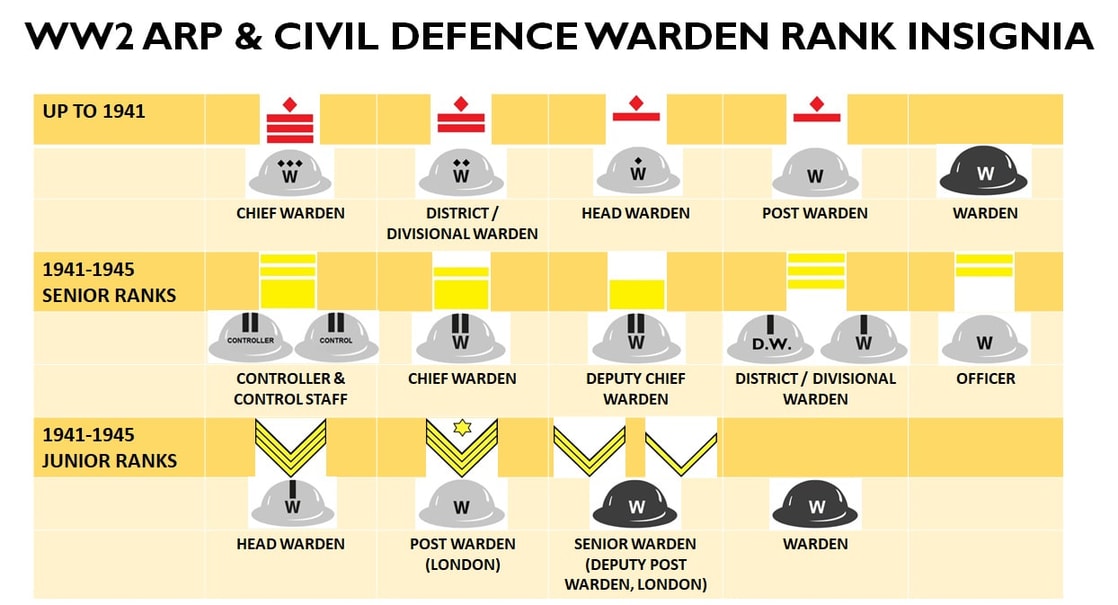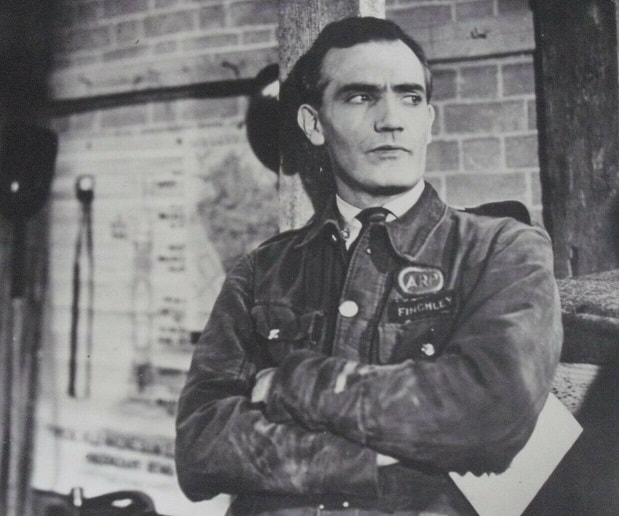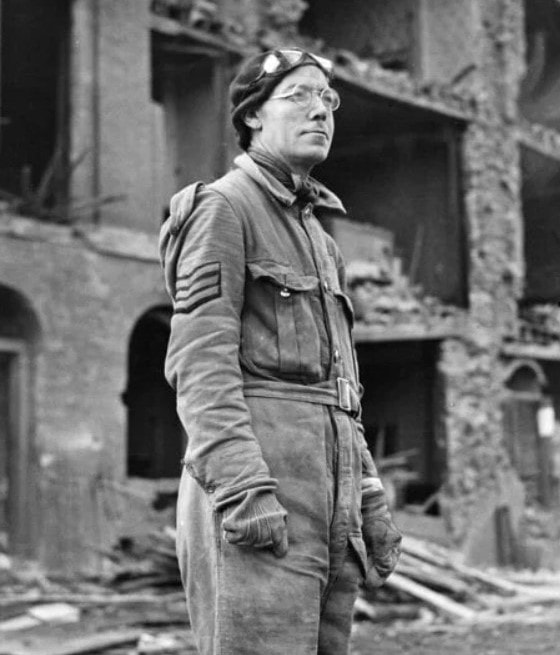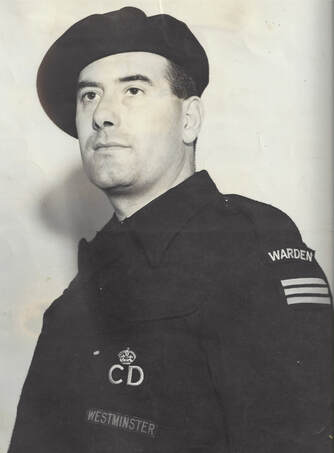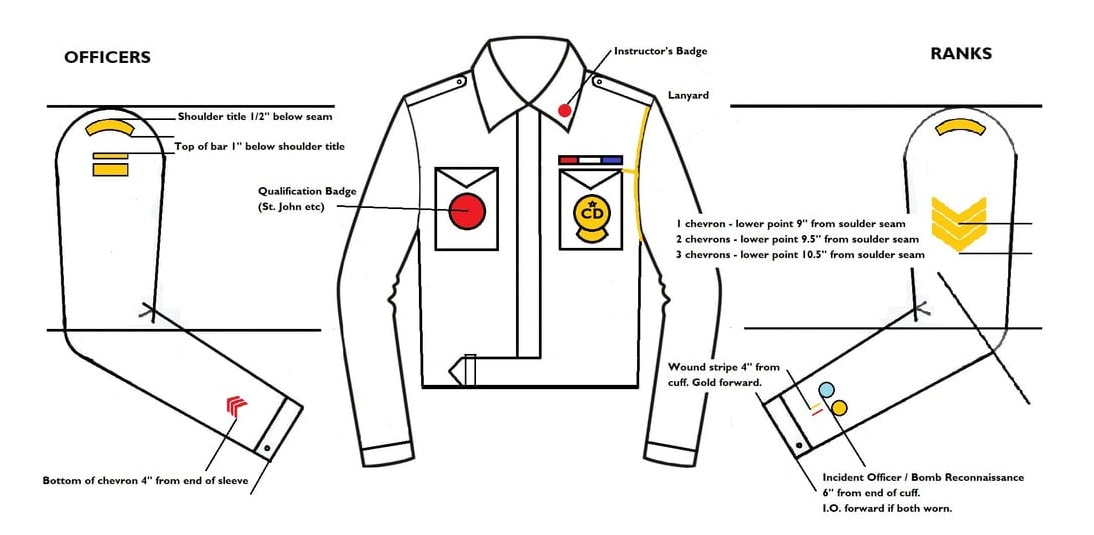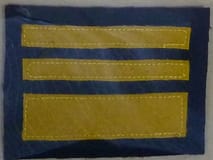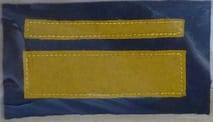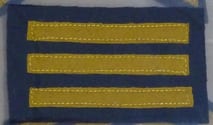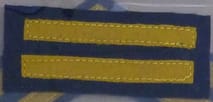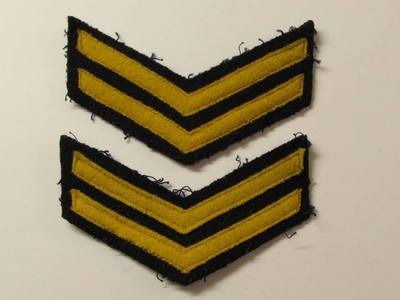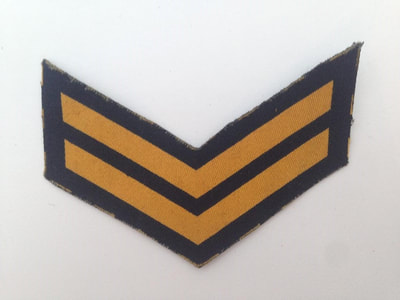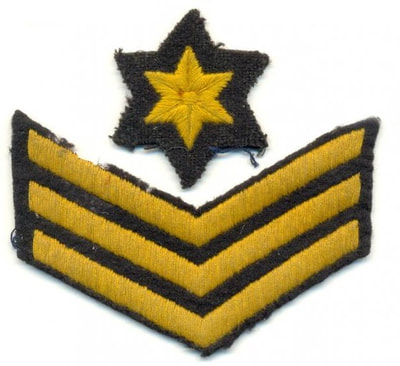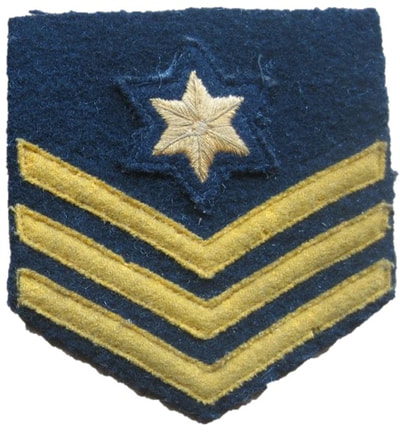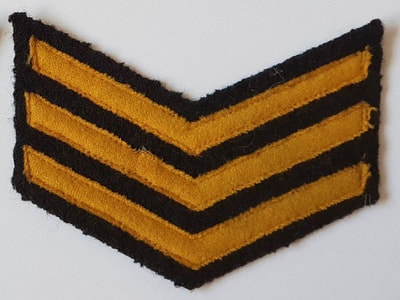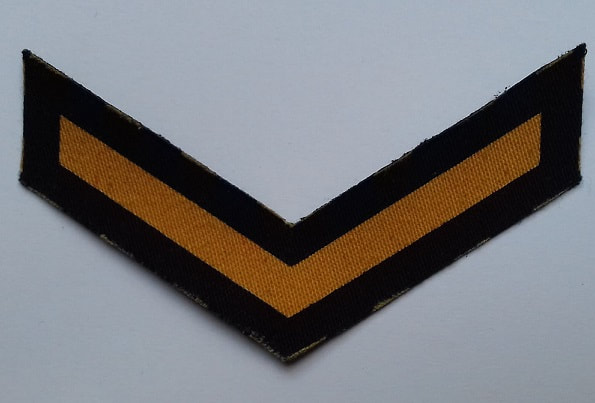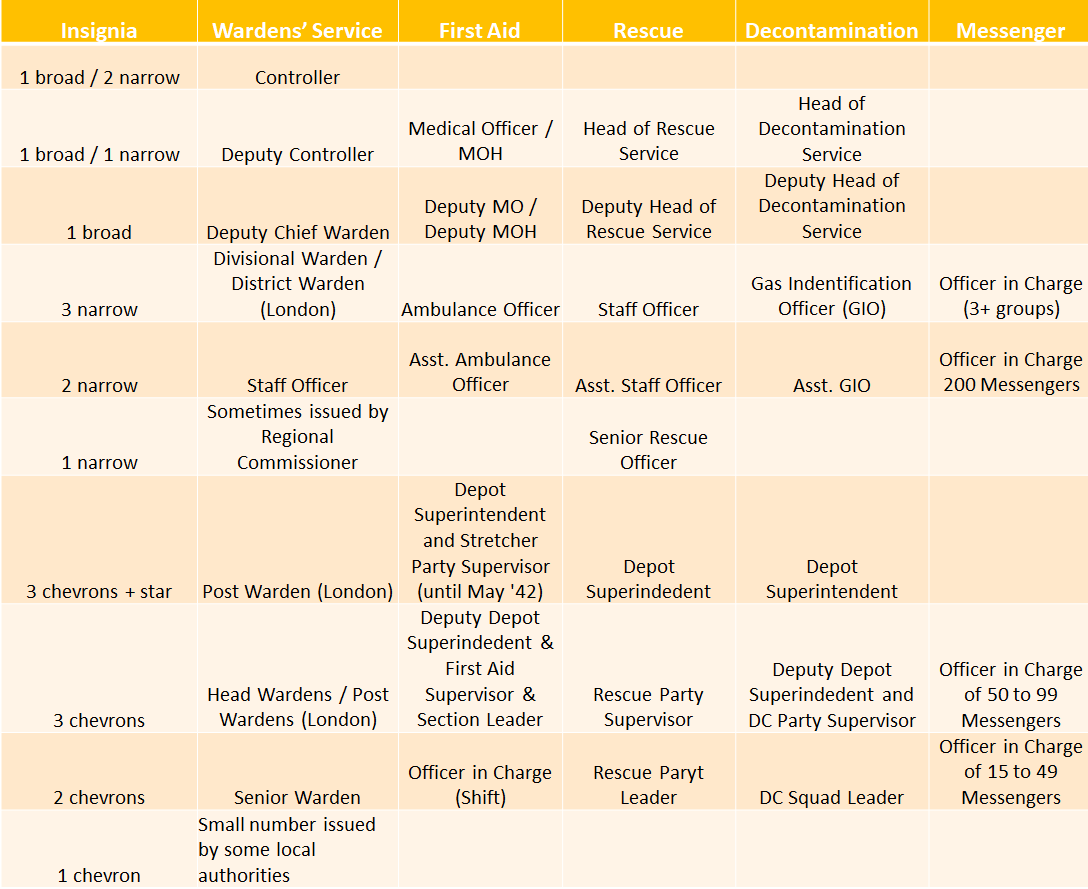WW2 Air Raid Warden, ARP & Civil Defence Rank Badges
Rank insignia for the various ARP services and from the autumn of 1941, the later Civil Defence General Services, developed in two distinct phases during the second world war. The early war Wardens' Service saw red braid bar and diamond insignia and red chevrons for Decontamination, Rescue and Stretcher Parties, worn on bluette overalls. The red braid insignia was replaced in the autumn of 1941 with 'old gold' badges of rank for both senior and junior supervisory roles. The new insignia was introduced along with the new serge battledress for men and tunics for women.
Chart of the main ARP & Civil Defence rank insignia used in the second world war
Note: the above helmet markings were not always followed to the letter. Period film and photographs show some wardens wearing various helmet markings, for example, a Divisional Warden in London with two black stripes or a white helmet with a single stripe plus 'SDW' (for Sub-Divisional Warden). Although the use of diamonds on helmets was phased out there is documentary film evidence of them still be used in 1942 and possibly later.
London areas had District Wardens whilst areas outside of the capital had Divisional Wardens.
There is photographic evidence of a single narrow yellow bar being worn. This rank was issued at the discretion of a Regional Commissioner.
London areas had District Wardens whilst areas outside of the capital had Divisional Wardens.
There is photographic evidence of a single narrow yellow bar being worn. This rank was issued at the discretion of a Regional Commissioner.
ARP Warden red bar & diamond rank badges/insignia - up to mid/late-1941
In a communique sent on 18 June, 1940 to the London Civil Defence Region specific regulations were sent regarding identifying insignia for Wardens. These were red braid bars 3" long by ½" inch wide and worn a ¼" apart with a single diamond (with sides of ½") placed a ¼" above the top bar. Insignia was worn on both sleeves with the lowest bar 4" from the cuff. Printed as well as red braid versions are known to exist.
Chief Warden - sleeve rank badges - three red braid bars with single red diamond
Divisional/District Warden - sleeve rank badges - two red braid bars with single red diamond
Post Warden & Head Warden - sleeve rank badges - one red braid bars with single red diamond
Divisional/District Warden - sleeve rank badges - two red braid bars with single red diamond
Post Warden & Head Warden - sleeve rank badges - one red braid bars with single red diamond
Original examples of the red bars & diamonds and sleeve chevrons are probably the hardest to find examples of the insignia issued to ARP personnel. To date, this author has not seen any originals with provenance in over 25 years.
Red braid chevrons for Party Leaders & Officers-In-Charge
The same document from June 1940 also listed two red braid chevrons for leaders of parties and three red braid chevrons for officers-in-charge of rescue, decontamination and stretcher parties. The chevrons were to be red braid 1/2" thick with each arm of the chevron 2" long. Chevrons were to be placed midway between shoulder and elbow on the bluette overalls with the chevron pointing down.
Location of insignia on bluette overalls (up to late 1941)
"Old Gold" yellow Civil Defence Service rank insignia ‒ 1941-45
Two distinct variations of insignia for senior and junior ranks were created with the formation of the Civil Defence Service in 1941 (the term civil defence had been used pre-war but the creation of a unified service brought all the various services under one roof). For senior ranks broad and narrow "old gold" yellow bars worn on the upper sleeve were introduced.
For junior ranks, chevrons in "old gold" yellow were worn in the similar place to other ranking systems in the army - midway between shoulder and elbow.
Both senior and junior ranks could become an Incident Officer. The incident officer wore a special IO badge on the lower left sleeve. They also wore a special blue covering on their helmet to make them stand out at air raid incidents. Incident Officers could be from any rank. For information on lanyards worn on the shoulder see this page.
There is photographic evidence of wardens wearing battledress with red braid bars and diamonds. This must have happened only for a short period in mid- to late-1941. It is assumed that although the battledress was available the badges of rank had yet to reach local authority stores.
Both senior and junior ranks could become an Incident Officer. The incident officer wore a special IO badge on the lower left sleeve. They also wore a special blue covering on their helmet to make them stand out at air raid incidents. Incident Officers could be from any rank. For information on lanyards worn on the shoulder see this page.
There is photographic evidence of wardens wearing battledress with red braid bars and diamonds. This must have happened only for a short period in mid- to late-1941. It is assumed that although the battledress was available the badges of rank had yet to reach local authority stores.
Location of Civil Defence insignia on battledress (1941-1945)
WW2 ARP & Civil Defence Services senior rank badge sleeve insignia
Rank insignia was "old gold" yellow on dark blue measuring 2½ inches wide by ¼ inch for the narrow bars and ¾ inch for the broad bars. Senior rank badges were worn with the top bar 1 inch below the shoulder title and were either printed or embroidered.
Controller - two narrow bars over single broad bar. Helmet - white with two black bars and word Controller.
Chief Warden - narrow bar over broad bar. Helmet - white with black W and two black stripes.
Medical Officer of Health - same insignia as Chief Warden but shoulder title was 'MOH' and helmet with MO (and MOH) and two black bars.
Deputy Chief Warden - a single broad bar. Helmet - white with black W and a double black stripe.
District / Divisional Warden - three narrow. Helmet - white with black W and one stripe (plus D.W. also used) .
Officer - two narrow. Helmet - white with black W.
Controller - two narrow bars over single broad bar. Helmet - white with two black bars and word Controller.
Chief Warden - narrow bar over broad bar. Helmet - white with black W and two black stripes.
Medical Officer of Health - same insignia as Chief Warden but shoulder title was 'MOH' and helmet with MO (and MOH) and two black bars.
Deputy Chief Warden - a single broad bar. Helmet - white with black W and a double black stripe.
District / Divisional Warden - three narrow. Helmet - white with black W and one stripe (plus D.W. also used) .
Officer - two narrow. Helmet - white with black W.
WW2 ARP & Civil Defence Services junior rank badge insignia
Junior rank insignia within the CD services were yellow stripes of one, two and three chevrons. The chevrons were either printed or embroidered.
Head Warden or Post Warden in London - three chevrons (sometimes with a six-pointed star above the chevrons). Helmet - white with black W (some with single black stripe), though P.W. was used also.
Senior Warden - one (rarely seen but used in some areas; some local authorities issued a single chevron to members who had performed two years' service) or two chevrons. Helmet - black with white W.
Head Warden or Post Warden in London - three chevrons (sometimes with a six-pointed star above the chevrons). Helmet - white with black W (some with single black stripe), though P.W. was used also.
Senior Warden - one (rarely seen but used in some areas; some local authorities issued a single chevron to members who had performed two years' service) or two chevrons. Helmet - black with white W.
Chevron rank badges were worn as follows:
1 chevron - lower point 9 inches below shoulder seam (note not shoulder title)
2 chevrons - lower point 9½ inches below shoulder seam
3 chevrons (with or without star) - lower point 10½ inches below shoulder seam
1 chevron - lower point 9 inches below shoulder seam (note not shoulder title)
2 chevrons - lower point 9½ inches below shoulder seam
3 chevrons (with or without star) - lower point 10½ inches below shoulder seam
Use of insignia across other Civil Defence Services from August 1942
The 'old gold' insignia was adopted across all Civil Defence Services from August 1942. The following table illustrates a general overview of how each rank was used. There were many local variations to this.
To submit original rank insignia please send me an email via the contact page.
Overview of the Wardens' Service
Sector – several wardens led by a Senior Warden. Each sector (covering a few streets) is numbered and/or lettered (covering approx. 500 people).
Post Area – several sectors form a Post Area which is numbered and/or lettered. Incidents within a sector are reported to the Wardens’ Report Post.
Wardens’ Report Post – headed by a Post Warden (assisted by a deputy). The report post usually centrally located to all sectors so Wardens/Messengers can easily reach it.
Head Warden (and deputy) – would oversee a group of Post Areas (approx. six to ten thousand people).
Divisional / District Warden (and deputy) – would oversee a whole district.
Chief Warden (and deputy) – would oversee several districts within a Local Authority.
Incident Officer – major air raid incidents would be managed by an Incident Officer at the scene who would take over reporting events to the Report Centre.
Report Centre – incidents are reported to the Report Centre from the Wardens’ Report Post / Incident Officer. Large areas may have more than one Report Centre. Report Centres have an Officer-in-Charge, Panel Operator, Plotting Operator and Telephonists.
CD Services – the Report Centre dispatches the various Civil Defence Services (police, fire, first aid, gas decontamination, rescue etc) from depots/stations to deal with the incident. The Plotting Operator numbers each incident on a map of the area and updates the map to indicate the type of incident (fire, gas, mains burst etc). The Panel Operator manages the services from depots to incidents.
Control Centre – the Report Centre updates the Control Centre which has a duplicate set of maps showing incidents across a Local Authority. The Controller (usually head of ARP for the Local Authority) follows each incident and can take charge in the event of a major incident unfolding. If this were to occur, Post Wardens/Incident Officers would be instructed to send reports direct to the Control Centre bypassing the Report Centre.
Group Control – a number of Local Authorities send information from Control Centres to the Group Control. In the event of one area being overwhelmed by an air raid the Local Authority can appeal for assistance utilising Group Reserves (later CD Reserve and Mobile Columns).
Civil Defence Region – all groups report into one of 12 Civil Defence Regional HQs. If a widespread heavy raid takes place, one Region can appeal to others for assistance.
Ministry of Home Security War Room – all Regional HQs reported to the Ministry of Home Security (based in London). The ministry would have an overview of the entire nation’s civil defence situation and could send assistance from one CD region to another.
Post Area – several sectors form a Post Area which is numbered and/or lettered. Incidents within a sector are reported to the Wardens’ Report Post.
Wardens’ Report Post – headed by a Post Warden (assisted by a deputy). The report post usually centrally located to all sectors so Wardens/Messengers can easily reach it.
Head Warden (and deputy) – would oversee a group of Post Areas (approx. six to ten thousand people).
Divisional / District Warden (and deputy) – would oversee a whole district.
Chief Warden (and deputy) – would oversee several districts within a Local Authority.
Incident Officer – major air raid incidents would be managed by an Incident Officer at the scene who would take over reporting events to the Report Centre.
Report Centre – incidents are reported to the Report Centre from the Wardens’ Report Post / Incident Officer. Large areas may have more than one Report Centre. Report Centres have an Officer-in-Charge, Panel Operator, Plotting Operator and Telephonists.
CD Services – the Report Centre dispatches the various Civil Defence Services (police, fire, first aid, gas decontamination, rescue etc) from depots/stations to deal with the incident. The Plotting Operator numbers each incident on a map of the area and updates the map to indicate the type of incident (fire, gas, mains burst etc). The Panel Operator manages the services from depots to incidents.
Control Centre – the Report Centre updates the Control Centre which has a duplicate set of maps showing incidents across a Local Authority. The Controller (usually head of ARP for the Local Authority) follows each incident and can take charge in the event of a major incident unfolding. If this were to occur, Post Wardens/Incident Officers would be instructed to send reports direct to the Control Centre bypassing the Report Centre.
Group Control – a number of Local Authorities send information from Control Centres to the Group Control. In the event of one area being overwhelmed by an air raid the Local Authority can appeal for assistance utilising Group Reserves (later CD Reserve and Mobile Columns).
Civil Defence Region – all groups report into one of 12 Civil Defence Regional HQs. If a widespread heavy raid takes place, one Region can appeal to others for assistance.
Ministry of Home Security War Room – all Regional HQs reported to the Ministry of Home Security (based in London). The ministry would have an overview of the entire nation’s civil defence situation and could send assistance from one CD region to another.
Post-war insignia and badges of the Civil Defence Corps
The Civil Defence Corps was created in 1949 and although they adopted similar ranks as the wartime Civil Defence Service, there are subtle differences in the shape, size and material used for both senior and junior ranks. Badges are on thinner material, shoulder titles have squared ends and stars were five-pointed. The colour of embroidery thread also changed from the "old gold" to a more distinct brighter yellow.
See this page that details Civil Defence Corps badges and insignia.
See this page that details Civil Defence Corps badges and insignia.
